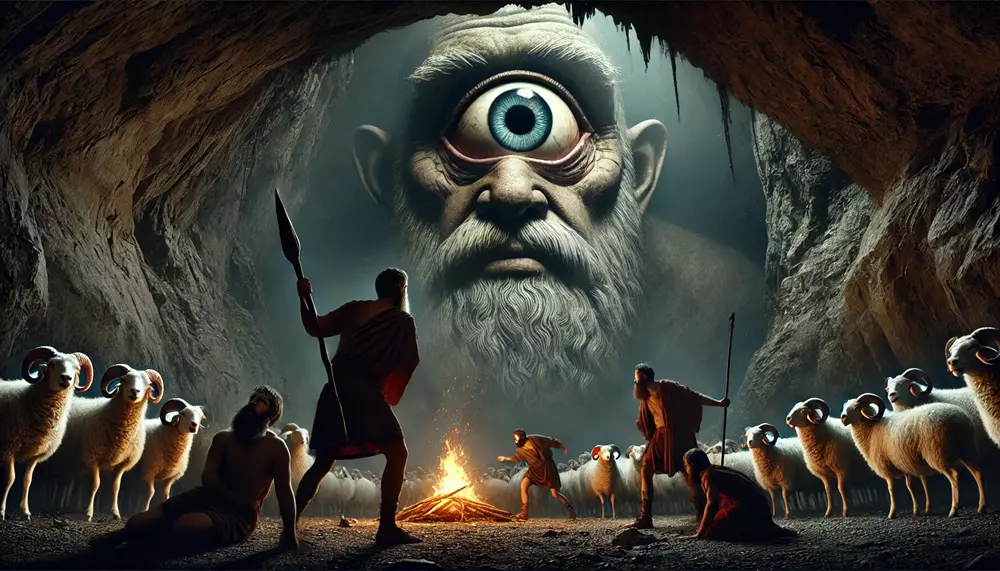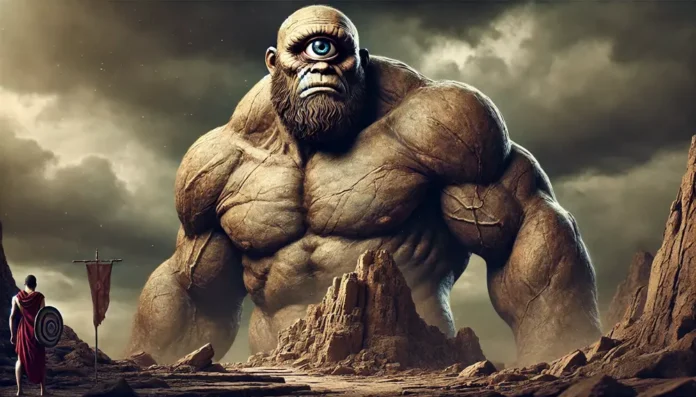Introduction
Cyclopes are ancient giants known for their single eye and unmatched strength. Originating from Greek myths, these one-eyed creatures were said to be both mighty and temperamental. The most famous Cyclops, Polyphemus, encountered Odysseus in Homer’s Odyssey, an encounter that showcased the Cyclops’ brute force and raw simplicity against human cunning. Cyclopes represent raw power, primal nature, and the unpredictable risks of confronting beings beyond mortal scale.
History/Origin
Cyclopes trace back to the epic Greek texts, particularly to Homer and Hesiod. Hesiod described three primordial Cyclopes: Arges, Steropes, and Brontes, who forged thunderbolts for Zeus and weapons for other gods. They were children of Gaia and Uranus, predating much of the familiar Greek pantheon. However, in Homer’s Odyssey, Cyclopes are depicted differently—as wild, solitary giants, like Polyphemus, with no alignment to gods or society.
The Cyclopes are portrayed as raw forces of nature, unbound by the rules of civilization. Their initial role as craftsmen gradually evolved to be synonymous with monsters, especially with Polyphemus’ violent episode in Odyssey, where he captures Odysseus and his men. This shift highlighted the Cyclops as both a tool of divine power and a creature of untamed land.
“When we entered the cave, we saw racks laden with cheese and pens full of lambs and kids, each sorted by age. The master of the cave was out, pasturing his flocks” (The Odyssey).
Name Meaning
“Cyclops” stems from the Greek Kyklops, meaning “round-eyed” (kyklos meaning circle, and ops meaning eye). This simple yet distinct term defines the creature’s iconic singular eye. The name has remained synonymous with one-eyed giants across literature, evoking an image of powerful beings whose vision—and power—can both threaten and protect.
Background Story
The Cyclopes’ background diverges between creators and monstrous beings. Hesiod’s Cyclopes were masterful blacksmiths, producing the thunderbolt, Poseidon’s trident, and Hades’ helmet of invisibility. Their significance to the gods and their role in crafting divine weapons made them integral to Olympus’ victories.

Homer, on the other hand, introduced a more brutal and independent Cyclops. Polyphemus, the most well-known, is famously outwitted by Odysseus. When the Cyclops trapped Odysseus and his men, he feasted on some, sparking Odysseus’ cunning plan: he tricked Polyphemus by declaring his name as “Nobody” and blinded him, escaping under the Cyclops’ own sheep. This tale highlighted the Cyclops’ simple mind against human wit.
Cultural Impact
The Cyclopes left an indelible mark on Greek art and symbolism. As early creators, they were seen as fundamental builders of power and weapons, celebrated in some ancient ceremonies of craftsmanship. However, their monstrous depictions led them to represent the dangers lurking in uncharted lands or the challenges awaiting heroes who dared venture into unknown territories.
Cyclopes appear frequently in Greek pottery and sculptures as both artisans and savage giants. Their duality resonates with themes of civilization versus nature, strength versus intelligence, and control versus chaos. This dichotomy of the Cyclops as both creator and destroyer mirrored the Greeks’ complex view of natural forces.
“The Cyclops Polyphemus represented raw, untamed power—neither inherently evil nor good, but undeniably formidable.”
Similar Beasts
In other cultures, one-eyed giants or beings appear in various forms. Norse mythology features the Jotnar, a race of giants embodying raw natural elements and often battling the gods. In Hindu texts, the Asura Bhasmasura represents a similar might that is ultimately bested by divine trickery, highlighting human intellect over brute force. The Hindu and Norse myths share the Cyclopes’ theme of the hero overcoming larger, primal forces.
Religion/Ritual
Though not worshiped, Cyclopes symbolized primal forces and divine craftsmanship, valued qualities in ancient Greece. Their role as blacksmiths associated them with the god Hephaestus, the divine smith. Cyclopes were seen as natural forces to respect rather than deities to worship, embodying the relentless and sometimes indifferent aspects of the world. Rituals around weapon-making or metalwork sometimes invoked their strength and precision as protectors of craftsmanship.
Scientific or Rational Explanations
The myth of Cyclopes may have stemmed from ancient Greeks discovering fossilized skulls of large mammals with central nasal cavities that resembled eye sockets. This plausible misinterpretation of elephant skulls, in particular, could have inspired the image of one-eyed giants. Scholars also suggest the Cyclopes represent early attempts to grapple with natural forces and the unknown world, embodying both awe and fear.
Modern Cultural References
Cyclopes are prominent in modern media, embodying both brute strength and a mythical mystery. In Rick Riordan’s Percy Jackson series, Tyson the Cyclops showcases loyalty and strength, reshaping the Cyclops as a figure of protection. In The Chronicles of Narnia, Cyclopes serve as fierce allies of Aslan, symbolizing power over fear.
The role-playing game Dungeons & Dragons includes Cyclopes as creatures of brute force, adding depth with their varied cultural origins. Cyclopes also appear in video games like Assassin’s Creed Odyssey, where players encounter Polyphemus as a formidable challenge in Greece’s mythical landscape.
“Cyclopes like Tyson remind us that even the fiercest creatures have a softer side,” says Riordan, adding complexity to these giants in The Sea of Monsters.
In movies, Ray Harryhausen’s stop-motion Cyclops in The 7th Voyage of Sinbad became iconic for its menacing presence. Cyclopes have also inspired various comic book giants, often representing simplistic yet loyal characters. In manga and anime like One Piece, Oars represents a cyclopean figure, adding depth to the Cyclops’ legacy across cultures.
Conclusion
Cyclopes embody a balance between raw, untamed strength and the simple challenges of nature. As one-eyed giants, they are symbols of pure power, primal nature, and the mysteries of ancient craftsmanship. From Homer’s Odyssey to modern fantasy, the Cyclops continues to represent the age-old struggle of intelligence versus might, reminding us of the eternal allure of creatures larger than life.









